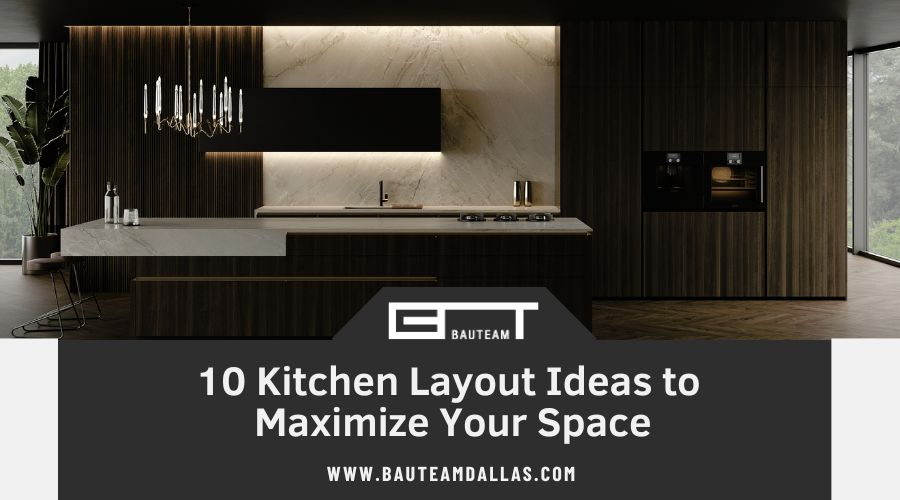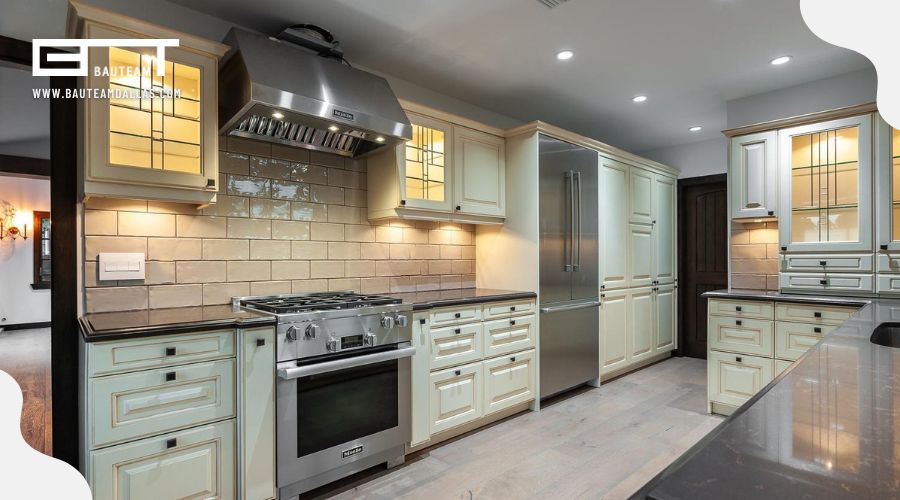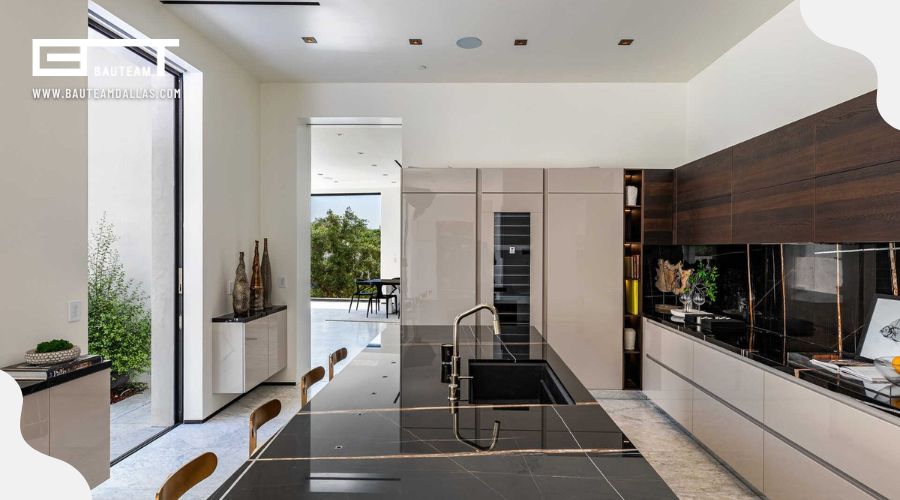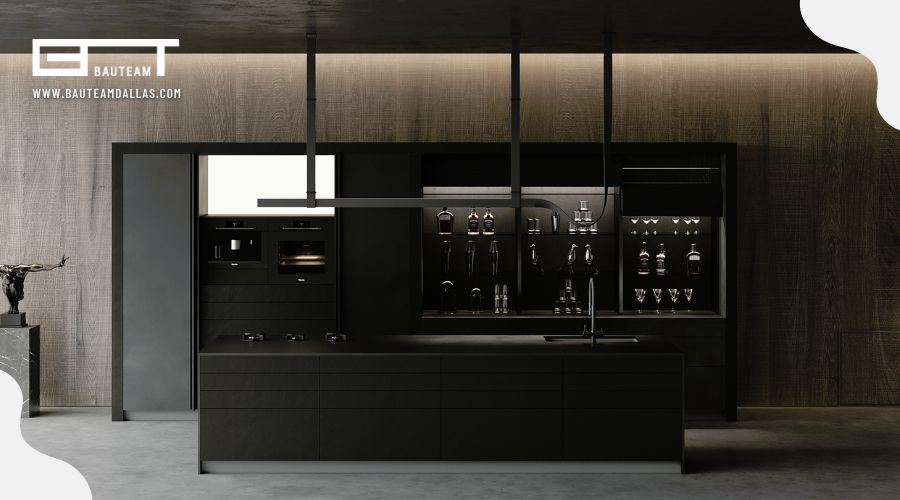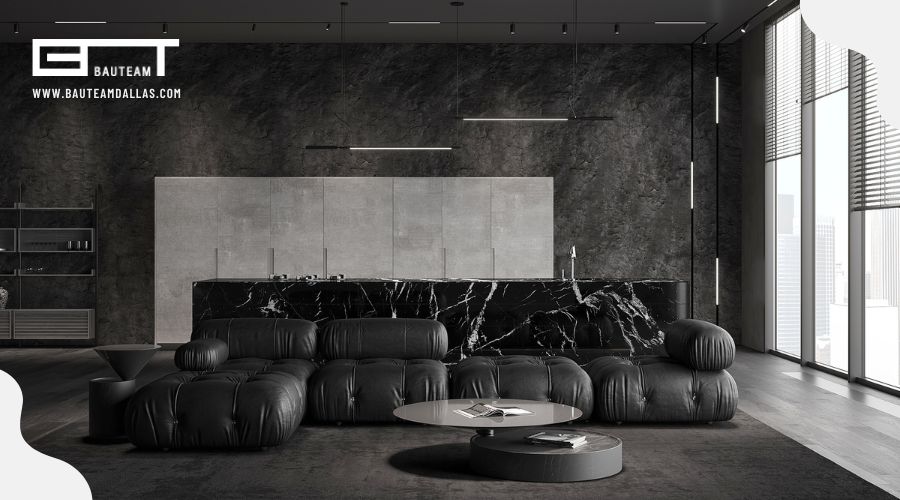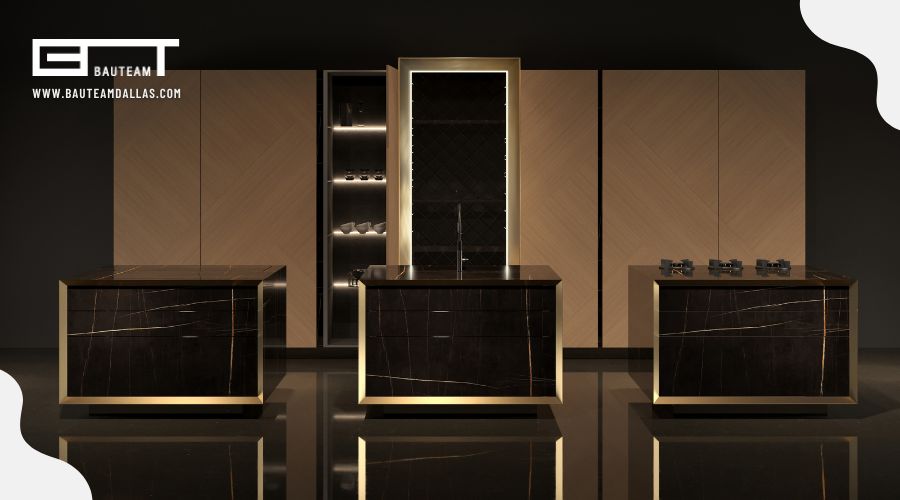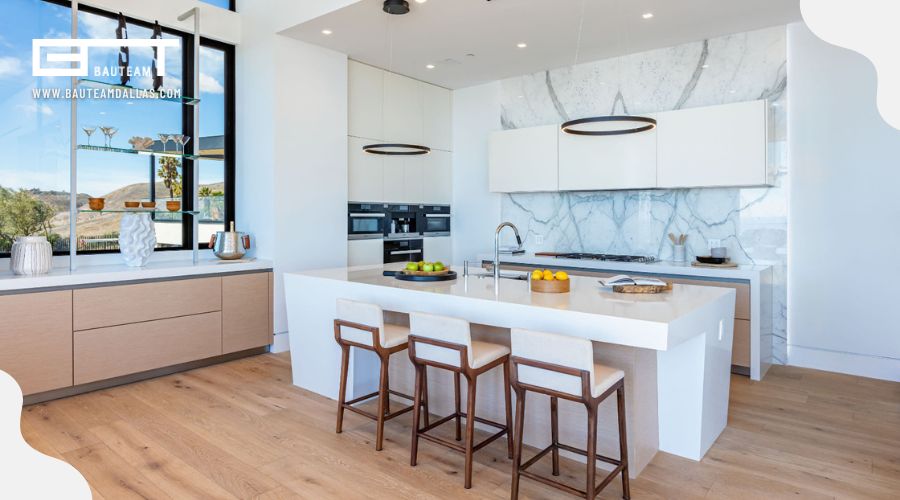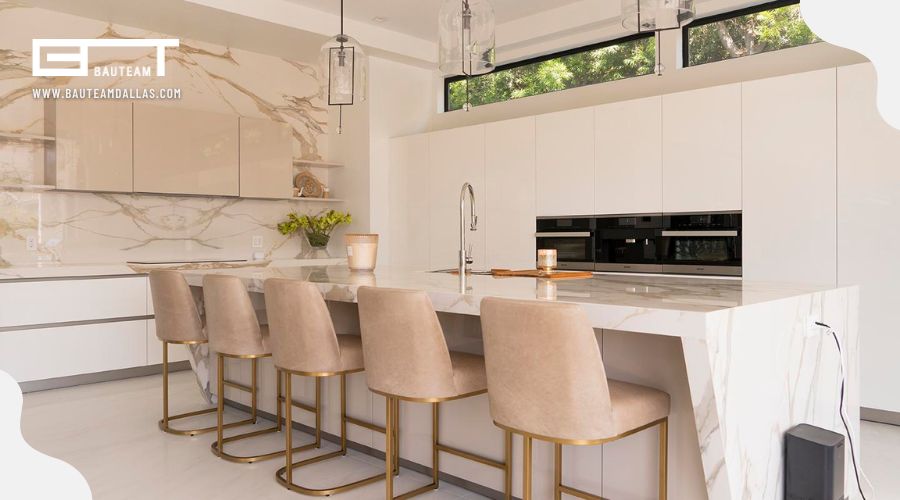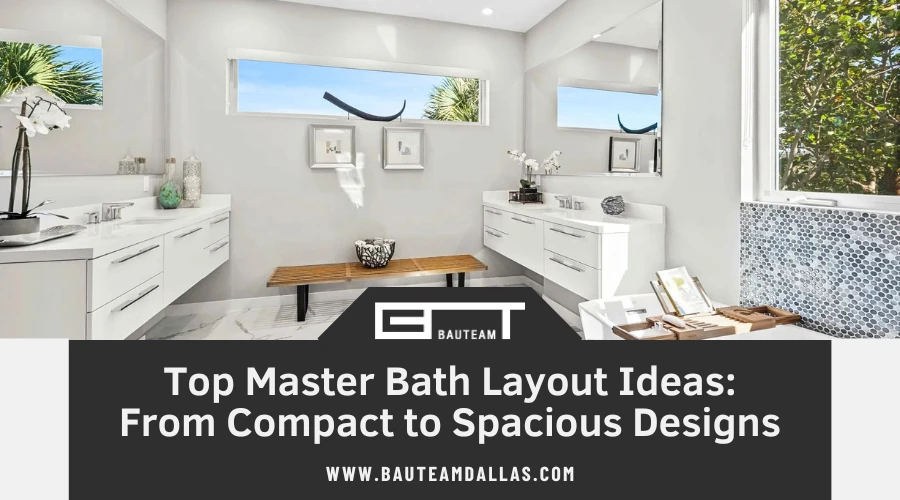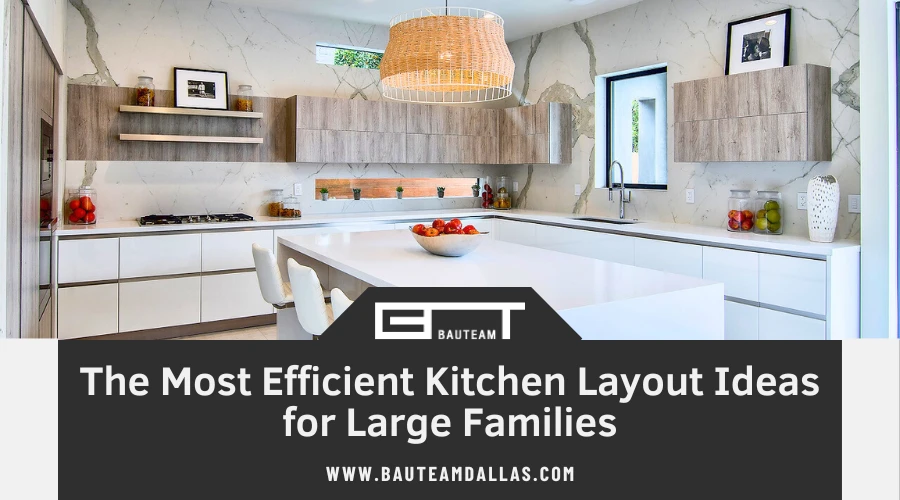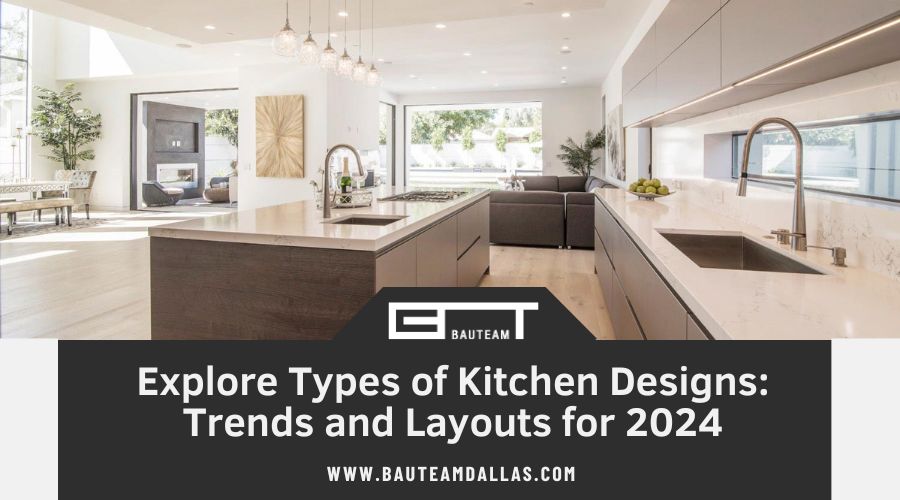When it comes to giving your home a fresh vibe, few things are as impactful as redesigning your kitchen. After all, the kitchen isn’t just a place to cook; it’s the heart of the home, where meals turn into memories. Getting your kitchen layout right can transform your space from cramped and chaotic to sleek and streamlined, making every inch count, especially in smaller homes. Today, we’re diving into 10 kitchen layout ideas that promise to maximize your space and boost both functionality and aesthetics.
Imagine cooking in a kitchen where everything is just where it needs to be, from the stove to the sink to that cozy breakfast nook. It’s not just about making your kitchen look good – it’s about creating a space that works for you, making your daily routine smoother and more enjoyable. Whether you have a tiny kitchen that needs to punch above its weight or a spacious area that feels a bit empty, the right layout can make all the difference.
Here’s a sneak peek of what you’ll learn:
- How to make the most of limited space with smart, one-wall kitchen layouts.
- The secrets to designing a galley kitchen that’s both functional and stylish.
- Why L-shaped kitchens are perfect for adding dining areas and maximizing corner space.
- The benefits of including an island or peninsula for that extra counter space and storage.
But that’s not all. We’ll also explore modern kitchen designs that blend seamlessly with your living space, offer innovative solutions for customization, and even dive into the world of smart kitchens. With these ideas, you’re not just renovating your kitchen; you’re reinventing it.
So, if you’ve ever felt your kitchen could use a bit more zest, stick around. You might just find the inspiration you need to start planning a kitchen that not only looks fantastic but also makes every cooking experience a breeze. Let’s unlock the potential of your kitchen together!
The Evolution of Kitchen Layouts
The way we design and use our kitchens has changed dramatically over the years. It’s not just about a place to cook any more; it’s about creating a space that brings people together, blends function with style, and meets the demands of modern living. Let’s explore how kitchen layouts have evolved and how current trends are shaping the kitchens of tomorrow.
Historical Perspectives on Kitchen Design
Back in the day, kitchens were simple, utilitarian spaces hidden away from the rest of the home. They were purely functional, with little thought given to aesthetics or the idea of the kitchen as a gathering place. Over time, as cooking became more than just a chore, people started paying attention to how kitchen spaces could be optimized not only for cooking but also for living.
Introducing modern kitchen appliances and innovative storage solutions transformed kitchens from cramped and dark rooms into bright, airy spaces. The open-concept kitchen layouts began to gain popularity, breaking down the barriers between the kitchen and living areas and inviting the whole family to participate in meal preparation and enjoy time together.
How Modern Needs Shape Kitchen Layouts
Today’s kitchen layouts are all about blending style, function, and technology. As we’ve become more interested in cooking and entertaining at home, the kitchen has taken center stage. Efficient kitchen designs and smart kitchen innovations are at the forefront of this transformation.
Modern kitchens need to be versatile, catering to a variety of activities beyond cooking, like dining, working, and socializing. This shift has led to the popularity of kitchen islands and peninsula kitchens, offering extra counter space, storage, and seating. These elements not only make the kitchen more functional but also more welcoming.
Sustainability and eco-friendliness have also influenced kitchen design. Eco-friendly kitchen layouts focus on energy-efficient appliances, sustainable materials, and designs that reduce waste, reflecting a growing awareness of environmental issues.
The rise of technology has ushered in the era of the smart kitchen, where appliances and systems connect to enhance convenience and efficiency. From refrigerators that can help you keep track of groceries to ovens that can be controlled with your smartphone, technology is making kitchens smarter and more user-friendly.
As our lives become busier, the need for space-saving kitchen solutions has become more pronounced. Creative storage ideas, multifunctional furniture, and custom kitchen configurations are designed to make the most of every inch of space, especially in urban homes where space is at a premium.
Kitchen remodeling tips often emphasize the importance of a layout that reflects the homeowner’s lifestyle. Whether it’s a galley kitchen layout for efficient cooking, an L-shaped kitchen for more open space, or a U-shaped kitchen to maximize storage, the goal is to create a space that works for you.
Analyzing Your Kitchen Space
Before you start picking out paint colors or dreaming about that new island, there’s one crucial step you can’t skip: measuring your kitchen. This might seem like a simple task, but getting it right is the foundation for creating a kitchen that’s both beautiful and functional. Let’s break down how to measure your space accurately and why it matters.
Measuring Your Space: The First Step to a Functional Kitchen
First things first, grab a tape measure, a piece of paper, and maybe a friend to help. You’re going to measure everything: the length and width of the room, the height of the ceilings, and the size of windows and doors. Remember, accuracy is key, so measure twice just to be sure.
Start with the Basics
Begin by sketching a rough outline of your kitchen on your piece of paper. It doesn’t have to be a masterpiece, but make sure to note where windows, doors, and any permanent fixtures are located. These are parts of your kitchen that won’t move, so you’ll need to plan around them.
Measure the Length and Width
With your tape measure, find the total length and width of the room. If your kitchen isn’t a perfect rectangle or square, break it down into sections and measure each one separately. This will give you a clear idea of the total space you have to work with.
Don’t Forget the Height
Ceiling height can greatly influence the feel of your kitchen and your storage options. Measure the height from floor to ceiling at several points in the room to account for any variations. This step is crucial for planning cabinetry and ensuring everything fits perfectly.
Windows and Doors Matter, Too
Measure the height and width of all windows and doors, including the frame. Knowing these dimensions is essential for planning your layout, especially if you’re considering adding new cabinets or appliances near them. Plus, you’ll need to think about natural light and how it moves through the space.
Consider the Details
Look at the placement of electrical outlets, plumbing fixtures, and any other elements that could affect your layout. You’ll want to know exactly where these are when you start planning where to put appliances and if you’re thinking about adding any new features, like an extra sink or a dishwasher.
Why Accurate Measurements Matter
Getting your kitchen’s measurements right is the first step toward making smart design choices. Whether you’re aiming for a modern kitchen layout or something more traditional, understanding your space helps you maximize functionality without sacrificing style.
For example, knowing the exact dimensions of your kitchen can help you decide if an island will fit, how much cabinet space you can add, or if a galley layout might be the best solution for your home.
A well-measured kitchen also means you can avoid costly mistakes. Imagine purchasing cabinets only to discover they don’t fit because the ceiling was lower than you thought, or a new fridge that blocks part of a window because the measurements were off. Taking the time to measure carefully at the start can save you a lot of headaches later.
Identifying Your Kitchen’s Potential and Limitations
After you’ve measured your kitchen, the next step is figuring out what you can do with the space. Every kitchen has its unique potential and limitations. Recognizing these will help you make the best decisions for your remodel. Let’s explore how to identify what’s possible in your kitchen and what might hold you back.
Look Beyond the Surface
Start by looking at your kitchen more deeply. What do you love about it? Maybe it’s the natural light or the way it feels when your family gathers there. These are the strengths of your kitchen, and you’ll want to keep them in mind.
Now, think about what doesn’t work. Is there not enough counter space for preparing meals? Do you always feel cramped? These are your kitchen’s limitations, but don’t worry, recognizing them is the first step to overcoming them.
Potential for Change
Your kitchen’s potential isn’t just about what you can see right now; it’s also about what it could become. Maybe there’s a wall that could be removed to open up the space, or perhaps you can add an island for more work area and storage. The key is to think creatively about how to use what you have.
For example, if you have high ceilings, you might add storage solutions up high. Or, if your kitchen has a great view, consider how the layout could be adjusted to take advantage of it. Even small kitchens have big potential with the right space-saving ideas.
Facing the Limitations
Some limitations will be harder to change. Structural walls, plumbing, and electrical systems can be costly to move. But that doesn’t mean you’re stuck. With smart kitchen innovations, you can work around these limitations.
If you can’t add more square footage, focus on maximizing the space you do have. This could mean choosing sleek, multi-functional furniture or installing cabinets that reach the ceiling for extra storage. Lighting can also play a big role in making a small kitchen feel larger and more inviting.
Make It Work for You
Think about how you use your kitchen. Do you love to cook big meals, or are you more about quick, simple dishes? Do you entertain often? Your answers will guide your design choices. For instance, a kitchen layout that’s great for one cook might not work well for a family that cooks together.
If you often have friends over, an open-concept layout might be best, allowing you to cook and chat at the same time. But if you’re tight on space, a galley kitchen can be incredibly efficient, keeping everything within easy reach.
Embrace Technology
Don’t forget about the role of technology in unlocking your kitchen’s potential. Smart appliances can make a big difference in how you use your space. A smart fridge can help you keep track of groceries, and a smart oven might be controlled remotely, saving you time and energy.
Envision the Future
Finally, think about the future. How can your kitchen grow with you? Maybe right now, you need a space that’s safe and accessible for young children, but in a few years, you might want a kitchen that’s more focused on entertaining. Consider flexible design features that can adapt to changing needs.
Space-Saving Kitchen Layout Ideas
One space-saving design that has gained popularity for its simplicity and efficiency is the one-wall kitchen. Let’s delve into how this layout maximizes minimalism and what you should consider to make it work beautifully in your home.
The One-Wall Kitchen: Maximizing Minimalism
The one-wall kitchen layout is exactly what it sounds like all cabinets, appliances, and countertops are positioned along a single wall. This setup is perfect for small homes or apartments where space is a luxury. But don’t let its simplicity fool you; with the right design tips and appliance choices, a one-wall kitchen can be as functional and stylish as larger kitchens.
Design Tips and Best Practices
First off, focus on clutter-free countertops. In a one-wall kitchen, counter space is golden. Opt for multi-functional furniture and appliances that can be tucked away or serve more than one purpose. For instance, a microwave that doubles as a convection oven, or a dishwasher with a cutting board top.
Next, consider vertical storage solutions. Since your horizontal space is limited, look up! Tall cabinets and shelving units can store a lot more than you might think, making them perfect for keeping your kitchen essentials at hand without cluttering the counter. Adding a magnetic knife strip or hanging pots and pans can also save valuable drawer and cabinet space.
Using light colors and reflective surfaces can make your kitchen feel bigger and brighter. Light-colored cabinets and countertops, along with a glossy tile backsplash, can reflect light and give the illusion of more space. Under-cabinet lighting is not just practical; it also adds depth and warmth to the kitchen.
Recommended Appliances and Fixtures
When it comes to appliances, think slim and trim. Look for compact, space-saving appliances designed for small kitchens, like narrow refrigerators and dishwashers. These are just as powerful as their full-sized counterparts but take up less room. An integrated sink and cutting board can also be a game-changer. This setup allows you to prep food right over the sink, saving counter space and making cleanup a breeze. Choose a deep, single-bowl sink to maximize usability.
Induction cooktops are great for one-wall kitchens. They’re sleek, take up less space than traditional ranges, and the top can double as extra counter space when not in use. Plus, they heat up quickly and are easy to clean. Don’t forget about the faucet. A wall-mounted faucet can save counter space, and a retractable spray head makes it easier to fill pots and clean the sink, even in tight spaces.
In a one-wall kitchen, every inch counts, so it’s essential to choose appliances and fixtures that offer the best functionality without taking up unnecessary room. With smart design choices and the right appliances, a one-wall kitchen can be a minimalist dream that offers everything you need to cook, clean, and enjoy your space.
Galley Kitchens: Streamlined Efficiency for Small Spaces
Galley kitchens, with their efficient use of space and streamlined design, are a smart choice for small homes and apartments. This layout features two parallel countertops with a walkway in between, resembling the cooking area of a ship—hence the name “galley.” Let’s dive into how to make the most of a galley kitchen, focusing on storage, counter space, lighting, and color schemes.
Optimizing Storage and Counter Space
In a galley kitchen, making every inch count is crucial. Here’s how you can maximize both storage and counter space:
- Use the full height of your kitchen for storage by installing cabinets that go all the way up to the ceiling. This not only gives you more room to store your items but also draws the eye upward, making the space feel larger.
- Pull-out drawers and shelves can make accessing pots, pans, and other kitchen essentials easier, ensuring that even the back of the cabinet is utilized.
- Hanging racks for pots and utensils can free up cabinet space and add a decorative element to your kitchen.
- Magnetic knife strips and spice racks installed on the wall save counter space and keep cooking tools within easy reach.
Lighting and Color Schemes for Galley Kitchens
The right lighting and color scheme can transform a galley kitchen from a narrow space into one that feels open and airy:
- Layered lighting is key. Combine overhead lighting with under-cabinet lights to illuminate the entire workspace and make the kitchen look larger.
- Use light colors on walls, cabinets, and countertops to reflect light and give the illusion of more space. Soft whites, light grays, and pastels are great choices.
- Add a pop of color with accessories or a backsplash to bring personality to your kitchen without overwhelming the space.
- Mirrored or glossy backsplashes can reflect light and create the illusion of depth, making your kitchen feel wider.
A galley kitchen might seem small, but with the right design choices, it can become a highly efficient and stylish space. By focusing on smart storage solutions and choosing the right colors and lighting, you can create a galley kitchen that not only meets your needs but also feels welcoming and spacious. If you’re a seasoned chef or a culinary novice, these tips can help you make the most of your kitchen, turning it into a place where cooking is a joy and not a challenge.
U-Shaped Kitchens: Optimizing Corner Spaces
U-shaped kitchens, with their practical layout and ample storage, are a favorite among homeowners. This design surrounds the cook on three sides with countertops, cabinets, and appliances, making everything within easy reach. Let’s explore how to maximize the potential of U-shaped kitchens, particularly in utilizing cabinets and integrating dining areas effectively.
Making the Most of Upper and Lower Cabinets
In a U-shaped kitchen, cabinets are key to organization and storage. Here’s how to use them wisely:
- Maximize corner storage with carousel shelves or lazy Susans in lower cabinets. These solutions make it easy to access items tucked in the back, ensuring no inch of space is wasted.
- Install over-the-counter cabinets that go up to the ceiling. This not only provides more storage but also draws the eye upwards, making the kitchen feel taller and more spacious.
- Use drawer organizers in lower cabinets to keep utensils and cookware neatly arranged and within reach. This helps avoid clutter and makes cooking more efficient.
- Consider glass-front upper cabinets or open shelving for a lighter feel. This can make the kitchen seem more open and is perfect for displaying dishes or collectibles.
Integrating Dining Areas in U-Shaped Layouts
Adding a dining area to a U-shaped kitchen can create a cozy and inviting space where family and friends can gather. Here are some tips to integrate dining seamlessly:
- Extend the countertop on one leg of the U to create a breakfast bar. This not only adds extra dining space but also allows the cook to interact with guests or family members during meal prep.
- Place a small table adjacent to the open side of the U. This can serve as an informal dining area or extra prep space when needed.
- Use bench seating against one wall of the U. This can save space compared to chairs and can be tucked under the table when not in use.
A U-shaped kitchen offers a great layout for those who love to cook, providing plenty of counter space and storage. By making smart choices with cabinets and finding creative ways to include dining areas, a U-shaped kitchen can become the heart of the home. Whether you’re whipping up a quick breakfast or hosting a dinner party, this layout keeps everything you need within arm’s reach while also offering a welcoming spot for guests and family members.
L-Shaped Kitchens: Flexible Design for Any Home
The L-shaped kitchen is a versatile layout that fits seamlessly into homes of all sizes, making it a popular choice for both new constructions and renovations. With countertops and cabinets placed along two adjoining walls, it forms a natural work triangle that optimizes the flow of kitchen activities. Let’s delve into the benefits of L-shaped layouts, especially in open floor plans, and uncover some innovative storage solutions for those tricky corners.
Advantages of L-Shaped Layouts in Open Floor Plans
L-shaped kitchens are a perfect match for open floor plans, offering several distinct advantages:
- Seamless integration with living spaces: The open end of the L shape naturally extends into dining or living areas, making it easier for families to interact and entertain guests without isolating the cook.
- Efficient use of space: This layout maximizes corner space and eliminates traffic through the work area, allowing for a more streamlined cooking experience.
- Flexible placement of appliances and work zones: The L shape provides ample flexibility in positioning major appliances, ensuring the kitchen work triangle is both compact and functional.
- Enhanced natural light: With more open wall space, L-shaped kitchens often benefit from additional windows, which can flood the space with natural light and make it feel more welcoming.
Creative Corner Solutions and Storage Ideas
Corners in L-shaped kitchens can be challenging, but with a bit of creativity, they can become your kitchen’s most valuable areas:
- Lazy Susans: A classic solution for hard-to-reach corner cabinets, lazy Susans make it easy to access pots, pans, and other essentials with a simple spin.
- Magic corners: These innovative pull-out cabinet inserts can transform a cumbersome corner into a storage powerhouse, with racks that slide out completely for easy access to items at the back.
- Corner drawers: Diagonal drawers are a clever way to make use of corner space, offering deep storage that’s perfect for larger items or a well-organized utensil station.
- Open shelving: For corners that can’t accommodate a cabinet or drawer, consider open shelving. It’s a great way to display decorative items or store everyday dishes in a way that’s both accessible and attractive.
An L-shaped kitchen offers a blend of efficiency and flexibility, making it an ideal choice for homes with open floor plans. By optimizing the layout for interaction and flow and employing smart storage solutions for corners, an L-shaped kitchen can cater to a variety of cooking styles and preferences. Whether you’re a gourmet chef or a casual cook, this layout adapts to your lifestyle, providing a functional and welcoming space for meal prep, dining, and family gatherings.
Modern Kitchen Layout Designs
As we move further into the realm of kitchen design, modern kitchen layouts have evolved to meet the changing needs and tastes of homeowners. Among these innovations, kitchen islands stand out as a symbol of both function and style. These versatile features can transform any kitchen into a more usable and social space, offering additional counter space, storage, and a focal point for family gatherings.
Kitchen Islands: Adding Function and Style
Choosing the Right Size and Shape for Kitchen Islands
The key to integrating an island into your kitchen is finding the perfect size and shape that complements your space without overcrowding it. Here’s how to make the right choice:
- Measure your kitchen: Ensure there’s enough room for movement around the island. A good rule of thumb is to have at least 3 feet of clearance on all sides for easy flow of traffic.
- Consider your needs: If you love to cook and entertain, you might opt for a larger island that can accommodate a sink, appliances, and seating. For smaller spaces, a slim, rectangular island might provide that extra counter space you need without taking up too much room.
- Shape matters: While rectangular islands fit well in most kitchens, consider an L-shaped or a T-shaped island if you’re looking for extra seating or need to fit the island in an unconventional space.
Features and Amenities of Modern Kitchen Islands
Modern kitchen islands are not just about adding counter space; they’re equipped with features and amenities that enhance their functionality:
- Built-in appliances: Many islands now include appliances like dishwashers, sinks, and wine coolers, making them an integral part of the kitchen’s working area.
- Storage solutions: With options for cabinets, drawers, and shelves, islands offer additional storage space for pots, pans, and utensils, keeping your kitchen organized and clutter-free.
- Seating: Adding stools or chairs to one side of the island creates a casual dining area and a spot for guests to relax and chat with the cook.
- Power outlets: Installing outlets in your island makes it a versatile spot for using small appliances, charging devices, or plugging in laptops, turning the kitchen into a multi-use space.
Incorporating a kitchen island into your design not only boosts your kitchen’s functionality but also its aesthetic appeal. Whether you’re looking for more prep space, additional storage, or a gathering spot for family and friends, a well-designed island can address these needs with style. Remember to consider the size, shape, and features that best fit your lifestyle to create a kitchen island that’s both beautiful and brilliantly functional.
Open-Concept Layouts: Merging Kitchen with Living Spaces
Open-concept layouts have revolutionized how we think about our living spaces, especially when it comes to merging the kitchen with living areas. This design not only makes spaces feel larger and more welcoming but also enhances the social aspect of the home, allowing families to spend more time together even when doing different activities.
Strategies for Seamless Integration
Creating a unified look between your kitchen and living areas is key to a successful open-concept layout. Here are some strategies to help achieve this:
- Use consistent flooring: Continuing the same flooring from the kitchen into the living area can help blur the lines between the spaces, making them feel like one cohesive area.
- Maintain a unified color scheme: Choose colors that flow naturally from one space to the next. Neutral palettes work well in open-concept layouts, with color pops used for accents.
- Install similar lighting fixtures: Lighting can play a big role in unifying different areas. Choose fixtures that complement each other and consider dimmers to adjust the ambiance as needed.
- Use a kitchen island as a transition: A well-placed kitchen island can serve as a natural divider that defines the kitchen space while keeping the flow open to the living area. It can also provide additional seating and storage.
Zoning and Flow Between Areas
Even in an open layout, it’s important to define different zones for cooking, dining, and relaxing. Here’s how to create a sense of order and flow:
- Rugs and furniture placement: Use area rugs to define different zones without erecting barriers. How you arrange your furniture can also signal the purpose of each area, such as a sofa facing away from the kitchen to create a distinct living space.
- Consider sightlines: When planning your layout, think about what you’ll see from different points in the room. For example, you might position the living area so it has a view of the backyard through the kitchen, creating a visual connection between indoors and outdoors.
- Open shelving and glass cabinets: These can create a sense of openness while still delineating the kitchen area. They provide storage and display space without blocking light or views.
- Varied ceiling heights: If possible, different ceiling heights can help designate different areas within an open-concept space. For instance, a raised ceiling in the living area and a cozier height in the kitchen can subtly define each space.
An open-concept layout that merges the kitchen with living spaces offers a modern and functional approach to home design. By applying these strategies for seamless integration and thoughtful zoning, you can create an environment that’s both beautiful and practical. This layout not only maximizes space and light but also fosters a sense of togetherness, making it perfect for today’s lifestyles.
Peninsula Kitchens: The Ideal Blend of Form and Function
Peninsula kitchens offer a unique solution for those seeking the functionality of an island in a more compact layout. Defined by a countertop that extends from the wall into the kitchen space, creating a peninsula, this design is both versatile and efficient. It’s an excellent choice for a variety of kitchen sizes, providing extra workspace, storage, and even dining options without requiring the same floor area as an island.
Benefits of Peninsula Layouts Over Islands
Peninsula layouts bring several advantages, especially in kitchens where space is premium or the layout doesn’t support a full island. Here are some key benefits:
- Improved traffic flow: Peninsulas define the kitchen space without obstructing movement, making them ideal for kitchens that open to living areas.
- Additional seating and workspace: Like islands, peninsulas offer extra counter space and can also include bar seating, making them perfect for quick meals or chatting with the cook.
- Versatile design options: Whether you have a U-shaped, L-shaped, or G-shaped kitchen, a peninsula can be adapted to fit, enhancing both form and function.
Design Ideas for Small and Large Kitchens
Whether your kitchen is cozy or expansive, there are peninsula designs to suit every size. Here are some ideas to inspire your kitchen layout:
- For Small Kitchens
- Slim peninsula designs: Opt for a narrow peninsula that provides extra counter space and seating without taking up too much room.
- Use as a room divider: A peninsula can act as a soft barrier between the kitchen and living areas, offering a sense of separation while keeping the space open and airy.
- Incorporate storage solutions: Maximize the functionality of your peninsula by including cabinets or drawers beneath the countertop for additional storage.
- For Large Kitchens
- Extended workspaces: In a larger kitchen, a peninsula can offer an extensive work surface, ideal for food prep or as a serving area during gatherings.
- Multi-level designs: Consider a two-tiered peninsula, with one level for cooking and another for dining or socializing. This not only adds interest but also defines different areas of use.
- Integrate appliances: Larger peninsulas can accommodate built-in appliances like dishwashers or wine coolers, further enhancing the kitchen’s functionality.
Peninsula kitchens merge the practicality of additional counter space and storage with the opportunity to create a more social kitchen environment. Whether serving as an informal dining spot, extra prep area, or a boundary between cooking and living spaces, peninsulas offer a smart solution for both small and large kitchens. By selecting the right design and features, you can make the most of this versatile layout, ensuring your kitchen is as functional as it is beautiful.
Innovative Kitchen Layout Solutions
Modular kitchens have emerged as a leading choice for kitchens that perfectly match personal style and functional needs. These innovative solutions offer flexibility and customization that traditional kitchens simply can’t match. Let’s delve into what makes modular kitchens so adaptable and explore how you can customize one to fit your home perfectly.
Modular Kitchens: Customizable for Every Homeowner
Modular kitchens are made up of pre-manufactured cabinet units that can be combined in various ways to fit any kitchen size and layout. This modular approach means that homeowners can enjoy a highly personalized kitchen without the need for bespoke cabinetry.
Understanding Modular Kitchen Components
At the heart of every modular kitchen are its components:
- Cabinets and drawers: These are the building blocks of modular kitchens, available in a variety of sizes and styles to store everything from utensils to appliances.
- Worktops: Choose from materials like granite, laminate, or stainless steel to get the look and functionality you need.
- Hardware: Soft-close hinges, telescopic channels, and handles add functionality and style to your kitchen units.
- Accessories: Pull-out baskets, corner solutions, and under-sink organizers help maximize storage space and keep everything within reach.
Customization Options and Styling Tips
The real beauty of modular kitchens lies in their ability to be customized. Here’s how you can make a modular kitchen your own:
- Select a layout that works for you: Whether you prefer an L-shaped, straight, or U-shaped kitchen, modular components can be arranged to suit any layout.
- Choose a color scheme: Modular kitchens offer a wide range of color options. Select one that complements your home’s decor and reflects your personality.
- Mix and match materials: Don’t be afraid to combine different materials and finishes for a unique look. For example, wooden cabinets with a quartz worktop can create a warm, inviting space.
- Add personal touches: Incorporate open shelving to display decorative items or choose glass-fronted cabinets to show off your favorite dishes.
Creating a kitchen that’s tailored to your needs and style preferences is easier than ever with modular kitchens. With their customizable components and flexible layouts, you can design a space that’s as unique as you are. Whether you’re a seasoned chef looking for a highly functional workspace or a design enthusiast wanting to make a style statement, a modular kitchen offers the perfect blend of form and function.
Eco-Friendly Kitchen Layouts: Sustainable and Chic
As we become more conscious of our impact on the planet, the demand for eco-friendly kitchens is on the rise. These sustainable spaces not only look chic but also play a crucial part in reducing our environmental footprint.
Let’s explore how incorporating green materials and technologies, along with some smart design choices, can create an eco-friendly kitchen that’s both stylish and sustainable.
Incorporating Green Materials and Technologies
Choosing the right materials and technologies is a big step toward a more eco-friendly kitchen. Here’s how you can make greener choices:
- Sustainable materials: Opt for cabinets and countertops made from recycled or sustainably sourced materials. Bamboo, for example, is a popular choice for flooring and cabinetry due to its fast growth rate and durability.
- Energy-efficient appliances: Look for appliances with high energy star ratings. These use less electricity and water, reducing your bills and your environmental impact.
- LED lighting: Switch to LED bulbs for your kitchen lighting. They last longer and use a fraction of the energy compared to traditional bulbs.
- Water-saving taps: Install taps with aerators or choose a smart tap that can reduce water use without sacrificing performance.
Energy Efficiency and Waste Reduction Tips
Beyond materials and appliances, there are several ways to design your kitchen for maximum energy efficiency and minimal waste:
- Smart layout: Design your kitchen to take advantage of natural light, reducing the need for artificial lighting during the day. Positioning windows and skylights strategically can make a big difference.
- Effective insulation: Proper insulation in your kitchen walls and floors can help maintain temperatures, reducing the need for heating and cooling.
- Composting solutions: Consider integrating a compost bin into your kitchen design. This can reduce food waste and provide you with natural fertilizer for your garden.
- Recycling stations: Create a designated area for recycling within your kitchen to make it easy to separate plastics, metals, and paper, encouraging more responsible waste management.
Adopting an eco-friendly kitchen layout isn’t just about making your space look good; it’s about making choices that benefit the environment and your well-being. From the materials you choose to the way you manage waste, every little bit helps in creating a kitchen that’s not only functional and beautiful but also kind to the planet. With these tips, you can enjoy a modern, stylish kitchen that aligns with your eco-conscious values, proving that sustainability and chic design can go hand in hand.
Smart Kitchens: Integrating Technology into Kitchen Design
Smart kitchens bring the future into our homes, making daily tasks easier, more efficient, and even more enjoyable. Let’s dive into the world of smart kitchen innovations and discover how integrating technology into kitchen design can revolutionize the way we interact with our cooking spaces.
The Latest in Kitchen Tech Innovations
The latest advancements in kitchen technology are all about making your kitchen smarter and more connected. Here are some of the cutting-edge innovations:
- Voice-activated assistants: Imagine controlling your kitchen appliances with just your voice. From preheating your oven to playing your favorite cooking playlist, voice-activated assistants can do it all.
- Smart refrigerators: These fridges can track expiration dates, create shopping lists, and even show you what’s inside without opening the door, all from your smartphone.
- Precision cookers: Also known as sous vide machines, these devices allow you to cook food to the perfect temperature by circulating water at a precise heat setting.
- Touchscreen cooktops: Replace knobs and buttons with sleek, touchscreen cooktops that offer precise control over cooking temperatures and can even provide cooking tips.
How Smart Appliances Enhance Functionality
Smart appliances are at the heart of the smart kitchen, offering functionality that was once the stuff of science fiction. Here’s how they’re changing the game:
- Increased convenience: With smart appliances, you can start your coffee maker from bed or preheat your oven on your way home from work, making meal prep quicker and more convenient.
- Energy efficiency: Many smart appliances are designed to be energy-efficient, using less electricity and water, which can help lower your utility bills.
- Personalized cooking experiences: Smart ovens can adjust cooking times and temperatures based on the recipe you choose, ensuring perfect results every time. Some can even learn your cooking habits and suggest recipes based on your preferences.
- Remote monitoring and control: Forgot to turn off the stove? No problem. Smart kitchen technology allows you to monitor and control appliances remotely, giving you peace of mind and added safety.
Smart kitchens represent the merging of technology with everyday living, offering solutions that simplify tasks, save time, and enhance our culinary experiences. By embracing these innovations, homeowners can create a kitchen space that’s not only equipped to handle the demands of modern life but also a place where cooking and technology come together in harmony.
Whether you’re a tech enthusiast or just looking for ways to make your kitchen more efficient, integrating smart appliances and innovations can transform your kitchen into a state-of-the-art space that’s ready for whatever the future brings.
Kitchen Layouts for Special Needs
Designing a kitchen that meets the needs of all users, including those with special needs, is not just a matter of convenience—it’s about creating a space that is safe, comfortable, and accessible for everyone. This approach to kitchen design, focusing on ergonomic principles and accessibility features, ensures that the heart of the home is welcoming and usable for people of all abilities.
Ergonomic Design for Comfort and Safety
Ergonomics is the science of designing environments to fit the individuals who use them rather than forcing individuals to adapt. In the kitchen, ergonomic design can greatly enhance comfort and safety, especially for those with special needs. Here are key considerations:
- Adjustable countertops: Having countertops at varying heights, or even better, adjustable ones, can accommodate users of different statures and those who may be seated in a wheelchair.
- Easy-to-reach cabinets: Wall cabinets can be installed lower than standard or with pull-down shelves, making it easier for everyone to reach what they need without straining.
- D-shaped handles: These handles are easier to grasp than knobs, beneficial for individuals with limited hand strength or dexterity.
- Slip-resistant flooring: Choosing flooring materials that minimize the risk of slips and falls is crucial in creating a safe kitchen environment.
Accessible Kitchen Features for Everyone
Creating an accessible kitchen goes beyond individual features. It’s about considering how someone with special needs interacts with the entire space. Here are ways to ensure your kitchen is accessible:
- Open floor plan: An open layout with plenty of turning space is essential for wheelchair users, allowing easy movement throughout the kitchen.
- Appliances at accessible heights: Placing microwaves, dishwashers, and other appliances at reachable heights makes them more usable for everyone.
- Front-controlled cooktops and ovens: These allow for safer, easier access without reaching over hot surfaces.
- Touchless faucets: Faucets with touchless technology or lever handles can be operated more easily by people with various abilities.
By incorporating ergonomic design and accessible features into kitchen layouts, we can create spaces that not only cater to special needs but also enhance the usability and safety of the kitchen for all family members. This thoughtful approach ensures that the kitchen remains the heart of the home, where everyone can gather, cook, and share meals comfortably and safely.
The Visual Appeal of Kitchen Layouts
Regarding kitchen design, how your space looks is just as important as how it functions. The visual appeal of your kitchen layout plays a crucial role in creating a welcoming and enjoyable space. A well-thought-out layout maximizes efficiency and brings beauty and harmony to your home’s heart. The look of your kitchen can greatly impact the overall feel of your home. Whether you’re cooking a meal, sharing a cup of coffee, or just hanging out, the visual elements of your kitchen layout contribute to the ambiance. Here’s how to ensure your kitchen is both beautiful and functional.
Creating a Focal Point
Every kitchen needs a focal point that draws the eye and sets the tone for the entire space. This could be an elegant island, a bold backsplash, or a statement light fixture. The key is to choose something that reflects your style and complements the rest of your kitchen’s design.
Balancing Function and Style
While your kitchen needs to look good, it must also work well. This means creating a balance between style and function. For example, open shelving can display beautiful dishes while keeping them within reach, and a kitchen island can provide extra prep space and a spot for friends and family to gather.
Color and Lighting
The colors you choose and how you light your kitchen can significantly affect its appearance. Light, neutral colors can make a small kitchen feel larger, while bold hues add drama and personality. Good lighting is also crucial; layered lighting that combines general, task, and accent lights can enhance your kitchen’s best features and make it more inviting. The colors you choose for your kitchen can influence how the space feels. Want to make your kitchen feel bigger and brighter?
- Light colors like soft whites or pale blues can open up the space. If you’re aiming for a cozy atmosphere, darker shades like deep greens or navy can add depth and warmth.
- Neutral palettes provide a timeless backdrop that you can personalize with colorful accessories.
- Bold colors can be used on a feature wall or as accent colors on the backsplash or cabinets to add a pop of personality.
- Warm tones like reds and yellows bring energy and appetite stimulation, making them great choices for a kitchen.
Materials and Finishes
The materials and finishes you select for your countertops, cabinets, and floors contribute to your kitchen’s visual appeal. Natural materials like wood and stone bring warmth and texture, while sleek, modern materials such as stainless steel and glass add a contemporary edge. Choosing materials that are both beautiful and durable ensures your kitchen will look great for years to come. The materials you select for your countertops, cabinets, and floors contribute to the kitchen’s look, functionality, and durability. Here are some popular choices:
- Granite and quartz countertops are highly durable and available in various colors, making them suitable for many kitchen styles.
- Hardwood flooring brings warmth and a natural feel to the kitchen, while ceramic tiles offer durability and easy maintenance.
- Cabinets made of solid wood offer a classic look and durability, whereas laminate provides a more budget-friendly option with a wide range of colors and patterns.
Mixing and Matching for a Unique Look
Don’t be afraid to mix and match materials and colors to create a unique kitchen design. Here are a few tips:
- Combine textures to add interest and depth to your kitchen. For example, glossy cabinets can be paired with a matte finish countertop.
- Metallic accents in gold, silver, or copper can add a touch of luxury and sophistication to your kitchen.
- Natural elements like wooden bar stools or a stone backsplash can introduce texture and warmth, creating a welcoming space.
Creating a cohesive color scheme and selecting the right materials are crucial steps in designing a kitchen that’s not only functional but also a beautiful part of your home. Whether you prefer a minimalist look with clean lines and neutral colors or a bold, eclectic style with vibrant hues and mixed materials, your kitchen is a canvas for creativity. By thoughtfully choosing each element, you can create a space that reflects your taste and meets your needs, making your kitchen the heart of your home.
Cohesion with the Rest of Your Home
Finally, your kitchen needs to complement the overall design of your home. If your house has a modern aesthetic, a kitchen with clean lines and minimalistic details might be best. For a more traditional home, a kitchen with classic cabinets and timeless materials would be a better fit. Creating a cohesive look helps your kitchen blend seamlessly with your home’s other spaces. The visual appeal of your kitchen layout is about more than just making a space that looks good; it’s about creating a place that feels like home.
By carefully considering each element, from the layout and focal points to colors, lighting, and materials, you can design a kitchen that’s both beautiful and functional, a space where memories are made and shared.
Lighting Design to Enhance Your Kitchen’s Look and Feel
Lighting is like the secret ingredient in your kitchen’s design recipe. It can change the mood, make tasks easier, and highlight your kitchen’s best features. Good lighting design combines different types of light to create a space that’s both beautiful and functional. Let’s shine some light on how to illuminate your kitchen in the best way possible.
Layer Your Lighting
To get the lighting right, think about layering different types of light. Each layer serves a different purpose:
- Ambient lighting provides overall illumination to the room. Ceiling-mounted or recessed fixtures that spread light evenly across the kitchen are perfect for this.
- Task lighting focuses light on areas where you work, like countertops, sinks, and stoves. Under-cabinet lights are great for this, making chopping and cooking safer and easier.
- Accent lighting adds drama or highlights architectural features. It could be in-cabinet lighting to showcase beautiful dishes or a focused light over a piece of art.
Choosing the Right Fixtures
The fixtures you choose play a big role in your kitchen’s overall look and feel. Here are some ideas:
- Pendant lights over the kitchen island or dining table not only provide direct lighting but also serve as a stylish decor element.
- Track lighting can be adjusted and directed where needed, making it versatile for both task and accent lighting.
- LED strip lights under cabinets or along toe kicks can add a modern touch and enhance the mood.
Getting the Brightness Right
Too much light can be as bad as too little, especially in a kitchen. You want to ensure that the light is bright enough for safety in cooking and prep areas but also adjustable for different times of the day:
- Dimmer switches let you control the brightness of your lights, making it easy to switch from bright task lighting to softer ambient light for dining.
- Color temperature is another thing to consider. Warmer lights (with a lower Kelvin rating) create a cozy atmosphere, while cooler lights (with a higher Kelvin rating) are better for task lighting because they’re closer to natural daylight.
Making the Most of Natural Light
Don’t forget about the most important light source of all: natural light. Maximizing natural light can make your kitchen feel brighter and more open:
- Use reflective surfaces like glossy tiles or countertops to bounce natural light around the room.
- Consider the window treatments. Sheer fabrics allow light in while providing privacy, whereas blinds or shades can be adjusted to control the light throughout the day.
Good lighting design is key to creating a kitchen that’s not only functional but also welcoming and comfortable. By carefully planning your lighting, you can transform the look and feel of your kitchen, making it a place where everyone loves to spend time. Whether you’re cooking up a storm or enjoying a quiet cup of coffee, the right lighting can make every moment in your kitchen brighter.
Planning Your Kitchen Layout
Getting your kitchen layout right is a key step in creating a space that’s both beautiful and functional. With the right planning tools and software, you can visualize your dream kitchen before any actual work begins, saving time, and money, and avoiding potential mistakes.
Kitchen Layout Planning Tools and Software
Today, there’s a variety of tools and software designed to make kitchen planning as easy as pie. Whether you’re a DIY enthusiast or working with a professional designer, these resources can help bring your ideas to life.
- Online planning tools: Many home improvement stores and kitchen design companies offer free online tools. These platforms allow you to create a 3D model of your kitchen, experiment with different layouts, and try out various cabinets, countertops, and appliances. You can adjust measurements to fit your space precisely, ensuring everything is just right.
- Professional design software: If you’re looking for more advanced features, there are professional-grade design programs like AutoCAD and SketchUp. These tools offer greater flexibility and precision, allowing for detailed plans and complex designs. They might have a steeper learning curve, but they’re worth it for the level of customization they offer.
- Mobile apps: For planning on the go, several mobile apps can turn your tablet or smartphone into a powerful design tool. Apps like Home Design 3D and Magicplan let you create floor plans and visualize changes in real time, offering a convenient way to tweak your design anytime, anywhere.
Tips for Using Planning Tools and Software
To make the most of these planning tools, keep these tips in mind:
- Measure twice: Before you start designing, ensure you have accurate measurements of your kitchen space. This includes the dimensions of windows, doors, and any fixed appliances or fixtures.
- Consider the work triangle: Keep the kitchen work triangle (the space between your stove, sink, and refrigerator) in mind when planning your layout. This principle helps create an efficient workspace where you can move freely between tasks.
- Don’t forget about storage: When experimenting with different layouts, think about storage solutions. Look for ways to incorporate enough cabinets and drawers to keep your kitchen organized and clutter-free.
- Play with options: One of the best parts about using design software is the ability to try out different ideas quickly. Don’t be afraid to explore various layouts, materials, and colors until you find the perfect combination for your space.
Planning your kitchen layout with the help of tools and software can make the design process much smoother. By visualizing your ideas ahead of time, you can make informed decisions, avoid common pitfalls, and end up with a kitchen that not only meets your practical needs but also matches your style. Whether you’re embarking on a complete remodel or simply refreshing your space, taking the time to plan carefully is the first step toward creating your ideal kitchen.
Tips for Visualizing Your Space Before the Renovation
Visualizing your kitchen space before starting a renovation is a crucial step. It helps you see potential changes, imagine living in the new space, and make adjustments before any real work begins.
Here are some tips to help you visualize your kitchen and ensure your renovation turns out just as you’ve dreamed.
- Create a Mood Board: Start by collecting images of kitchens you love, and samples of materials, colors, and finishes that catch your eye. A mood board can be a physical board or a digital collection, like a Pinterest board. It helps you pinpoint the style you’re drawn to and ensures your design elements will work together.
- Use Graph Paper for a Rough Sketch: Even if you’re using digital tools for detailed planning, starting with a simple sketch on graph paper can help you get a sense of space. Draw your kitchen layout, including windows, doors, and fixed appliances. This can help you think about traffic flow and the placement of new elements.
- Take Advantage of Online Design Tools: As mentioned earlier, online design tools and software allow you to create a 3D model of your kitchen. These platforms enable you to experiment with different layouts, cabinet styles, and color schemes, giving you a virtual tour of your future kitchen.
- Consider Sample Materials in Your Space: Materials can look very different in your home than they do in a showroom. Obtain samples of countertops, cabinetry, and flooring to see how they look in your kitchen’s lighting and against existing finishes. This will help you make decisions that you’ll be happy with in the long term.
- Mock-up Cabinets and Large Elements with Cardboard: If you’re considering major changes, like moving cabinets or adding an island, try creating full-size mock-ups out of cardboard or painter’s tape on the floor. This gives you a better sense of how these changes will affect your kitchen’s flow and usability.
- Consider the Lighting: Remember to think about both natural and artificial lighting. How will changes in your layout affect the light? Use your planning tools to experiment with different lighting setups and see how they illuminate your space.
- Get Feedback from Friends or Family: Sometimes, a fresh set of eyes can offer valuable insights. Show your plans and visualizations to friends or family members and get their feedback. They might notice things you’ve overlooked or offer suggestions that could improve your design.
- Visit Showrooms or Virtual Showrooms: Many companies now offer virtual showrooms alongside physical ones. Visiting these can help you see and feel products in a set-up kitchen, giving you a better idea of how they might look in your own space.
Visualizing your kitchen before starting a renovation can save you time, money, and disappointment. By using these tips, you can explore different designs and materials, ensuring your renovated kitchen will not only meet your functional needs but also reflect your style. Whether you’re doing a complete overhaul or making a few key updates, taking the time to carefully plan and visualize your space is an essential step toward creating your dream kitchen.
Maximizing Your Kitchen’s Potential
Maximizing your kitchen’s potential means more than just choosing the right colors and appliances. It’s also about smart planning to avoid common layout mistakes that could affect your kitchen’s functionality and your overall satisfaction with the space.
How to Avoid Common Kitchen Layout Mistakes
- Not Considering the Work Triangle: The work triangle – the area between your sink, stove, and refrigerator – should be efficient and unobstructed. Avoid placing these key elements too far apart or too close together. This ensures that cooking and cleaning are easier and more efficient.
- Forgetting About Storage: It’s easy to get caught up in aesthetics and overlook practical aspects like storage. Ensure you have enough cabinets and drawers for your needs. Utilize innovative storage solutions like pull-out shelves, corner cabinets, and ceiling-high storage to make the most of every inch.
- Insufficient Counter Space: One of the biggest complaints in kitchen design is not having enough counter space. Include ample work surfaces for food preparation and appliances. Consider adding an island or peninsula if space allows.
- Poor Lighting: A well-lit kitchen is essential for safety and ambiance. Combine ambient, task, and accent lighting to illuminate every area of your kitchen properly. Under-cabinet lighting is great for prep areas, while pendant lights can add style and focus over an island.
- Overlooking Ventilation: Good ventilation is crucial to keep your kitchen air clean and fresh. An effective range hood that vents to the outside is a must-have to remove smoke, grease, and odors.
- Neglecting the Flow: Your kitchen should allow easy movement between different areas and not feel cramped. Keep the layout open and consider the paths you take during cooking tasks. Avoid placing islands too close to appliances or cabinets, ensuring there’s enough room to move around comfortably.
- Ignoring Your Lifestyle: Your kitchen should reflect how you use it. If you love to entertain, consider an open layout with a large island that can serve as a gathering spot. For avid cooks, prioritize professional-grade appliances and ample prep space.
- Choosing Trends Over Timelessness: While it’s tempting to go for the latest design trends, consider how your choices will age over time. Opting for classic elements that match your style ensures your kitchen remains a space you love for years to come.
- DIYing Complex Projects: Some kitchen updates can be DIY-friendly, but major renovations often require professional expertise. Hiring a contractor or designer can help you avoid costly mistakes and ensure the work meets safety standards.
By avoiding these common mistakes, you can maximize your kitchen’s potential and create a space that’s not only visually appealing but also highly functional. Remember, the best kitchen is one that suits your lifestyle and needs, making your daily routines more enjoyable and efficient. Whether you’re renovating or just making a few updates, thoughtful planning and attention to detail are key to achieving the kitchen of your dreams.
Optimizing Storage in Your Kitchen Layout
Getting your kitchen storage right is like solving a puzzle — every piece needs to fit perfectly to make the most of the space you have. Optimizing storage in your kitchen layout isn’t just about having enough cabinets and drawers; it’s about making everything accessible and keeping your kitchen organized and clutter-free.
Creating a kitchen with ample storage starts with smart planning. Here’s how to ensure every utensil, appliance, and ingredient has its place:
- Think Vertically: Use the full height of your kitchen for storage. Tall cabinets that reach the ceiling can store rarely used items on the higher shelves, while everyday items remain within easy reach. This strategy makes use of often overlooked space, providing extra storage without taking up more floor area.
- Incorporate Pull-Out Cabinets: Pull-out cabinets are a game-changer for deep storage spaces. Instead of rummaging through a dark cabinet to find what you need, you can pull out the entire cabinet to easily access every item. This is especially useful for pots, pans, and pantry items.
- Use Drawer Dividers: Keep your drawers organized with dividers that separate utensils, cutlery, and other kitchen tools. This simple addition can turn a jumbled drawer into a well-organized storage space, making it quick and easy to find what you need.
- Add a Pantry Cabinet: If space allows, a pantry cabinet can be valuable to your kitchen. It provides a dedicated space for dry goods and larger kitchen items, keeping them organized and accessible while freeing up other storage areas for different uses.
- Under-Sink Storage Solutions: The space under the sink is often underutilized. With the right storage solutions, like pull-out trays or organizers, you can neatly store cleaning supplies and waste bins, keeping them out of sight but within easy reach.
- Corner Cabinet Solutions: Corner cabinets can be tricky to use efficiently. Options like a lazy Susan or magic corner units transform these awkward spaces into highly functional storage areas, making accessing even the deepest corners easy.
- Open Shelving for Everyday Items: While not suitable for every kitchen, open shelving offers an easy-access solution for daily items. It can also serve as a display area for decorative items or a collection of dishes, adding personality to your kitchen.
- Over-the-Island Hanging Storage: If you have a kitchen island, consider using the space above it for hanging storage. A rack for pots and pans adds storage and becomes a focal point in the kitchen, adding to the overall design.
- Integrated Appliance Garages: Small appliances can clutter countertops. An appliance garage is a dedicated cabinet space where appliances can be stored out of sight but pulled out when needed, keeping counters clear and your kitchen tidy.
Optimizing storage in your kitchen layout requires a blend of creativity and practicality. By utilizing every inch of available space and incorporating smart storage solutions, you can create a kitchen that’s organized and a joy to use. Whether you’re dealing with a compact kitchen or have room to spare, these tips can help you achieve a functional, clutter-free kitchen.
Bringing Your Kitchen Layout Ideas to Life
After dreaming up your perfect kitchen layout, the next step is to bring those ideas into the real world. This exciting phase involves selecting the right materials and appliances and possibly working with kitchen design professionals to ensure your vision comes to life exactly as you imagine.
Selecting the Right Materials and Appliances
Choosing the materials for your countertops, cabinets, and floors, along with the appliances, is not just about looks; it’s about finding the perfect balance between style, durability, and budget.
- Countertops: Look for materials that can withstand the wear and tear of daily use. Granite, quartz, and laminate are popular choices, each offering different benefits in terms of aesthetics, resistance to heat and scratches, and cost.
- Cabinets: The material you choose for your cabinets will impact the overall look of your kitchen. Solid wood, plywood, and MDF are common options, each with its advantages in appearance, durability, and cost.
- Flooring: Your kitchen floor needs to be tough yet beautiful. Hardwood, tiles, and vinyl are excellent choices, each providing different looks and ease of maintenance.
- Appliances: When it comes to appliances, consider energy efficiency and how each piece fits into your kitchen’s design. Stainless steel appliances are popular for their sleek look and durability, but be sure to choose models that meet your cooking needs and fit the overall design of your kitchen.
Remember, the key is to choose materials and appliances that look great and fit your lifestyle and the practical needs of your kitchen.
Consulting with Kitchen Design Professionals
While it’s possible to plan and execute a kitchen renovation on your own, consulting with kitchen design professionals can offer numerous benefits.
- Expertise: Professionals bring a wealth of knowledge about the latest trends, materials, and technologies. They can help you make informed decisions that align with your vision and budget.
- Efficiency: A professional can help streamline the renovation process, from planning to execution, ensuring that your project stays on track and within budget.
- Custom solutions: Designers can offer custom solutions that maximize the functionality and beauty of your kitchen, often coming up with ideas you might not have considered.
- Avoiding mistakes: One of the biggest advantages of working with a professional is their ability to foresee potential problems and suggest alternatives, saving you time and money in the long run.
Whether you decide to DIY your kitchen renovation or work with a professional, the key is thorough planning and carefully selecting materials and appliances. By taking the time to research your options and possibly consulting with experts, you can ensure that your renovated kitchen is not only beautiful but also a perfect fit for your lifestyle and needs. Bringing your kitchen layout ideas to life is an exciting journey, and with the right approach, you can create a space that you’ll love for years to come.
Frequently Asked Questions:
What is the most efficient kitchen layout?
The most efficient kitchen layout often depends on your space and needs. Still, many find the work triangle concept (arranging the sink, refrigerator, and stove in a triangular layout) highly effective. This setup minimizes unnecessary movement and allows easy access between the three most used areas in the kitchen.
How do I choose the right kitchen layout for a small space?
For smaller kitchens, galley or L-shaped layouts can be great choices. These layouts efficiently use limited space, offering ample storage and countertop space without overcrowding. Incorporating innovative storage solutions and choosing sleek, compact appliances can also help maximize space.
What are the latest trends in kitchen layout designs?
Recent trends include open-concept kitchens that blend seamlessly with living spaces, smart kitchens equipped with the latest technology, and sustainable kitchens that use eco-friendly materials and energy-efficient appliances. Minimalist designs with clean lines and neutral color palettes are also popular.
How can I incorporate an island into my small kitchen layout?
If you’re short on space but dream of adding an island, consider a slim, mobile island that can be moved as needed. Choose an island with open shelving or cabinets for additional storage. Ensure there’s enough clearance around the island for easy movement.
Are open-concept kitchens going out of style?
Open-concept kitchens remain popular for their ability to make homes feel larger and more inclusive. While some homeowners choose designs with a bit more separation between spaces, the desire for kitchen and living areas that promote social interaction continues to influence kitchen design trends.
Elevate Your Kitchen with BauTeam German Kitchen Tailors
At BauTeam German Kitchen Tailors in Dallas, TX, we’re here to turn your dream kitchen into reality. Our team of experts specializes in custom kitchen solutions that blend functionality with cutting-edge design. Whether you want to renovate your entire kitchen or simply update a few aspects, we offer personalized guidance and high-quality craftsmanship to ensure your space meets your every need and desire. Reach out to BauTeam German Kitchen Tailors today, and let’s start creating the heart of your home together. Your perfect kitchen is just a consultation away!
